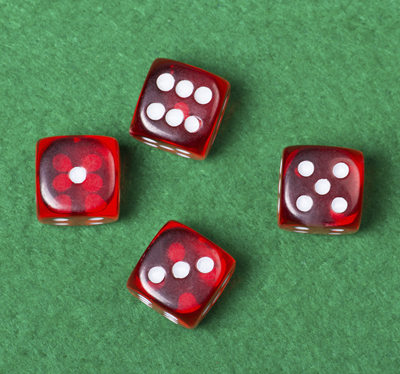
 |

|
One of the arguments made by theists1 against the philosophical position of atheists is that they would not want to live in a universe governed by accident and chance. They hate the idea that the world and its beauty, the human body and its intricacy, the human mind with its incredible understanding, and everything else we can see and know are all the result of a set of flukes, a once-in-a-trillion roll of the dice, and just as likely—no, even more likely—to have resulted in some horrible, unrecognizable, broken muddle.
I cannot speak for the laws of physics and chemistry, which govern the galaxies, stars, and formation of the planets. And yes, some of the galaxies do seem to be misshapen. Most stars eventually explode. And a number of the planets we’ve found so far are a horrible, broken muddle, not fit for habitation by any creature we know. But I do have some understanding of biology and evolution, having spent 15 years of my professional life in the biotech business, including a decade with the foremost manufacturer of genetic analysis equipment.2
People who distrust evolution and consider its products to be a mere accident are suffering from a misconstruction of the real nature of evolution. Accidents, chance, mistakes, or rolls of the dice do not govern evolution. They merely set the process in motion. After that, the process is strictly controlled.
The commonest of these accidents is a genetic mutation: a bit of stray radiation, a random chemical interaction, or just a kink in a chromosome can cause one of the four letters used in the genetic code3 to swap with one of the others, or to drop out entirely. Sometimes a chromosome breaks off and swaps a piece of itself with a neighboring chromosome, scrambling the code even further.4
But the genetic code itself is fairly redundant. Except for the X and Y chromosomes, we human beings all have two copies of each chromosome, giving us a completely redundant set of genes. And many people may also have more than one copy of a gene on any chromosome. And then again, the protein-coding genes themselves are partially redundant. That is, they use the four letters of the genetic code in sets of three, which are called a codon or the “reading frame.” Reading the code in triplets produces 64 possible combinations,5 but all of those combinations are used for calling out only 21 different amino acids needed to make proteins. The result is that many of those combinations are used for calling the same amino acid. And even then, the first two letters of the triplet are generally more meaningful than the third letter that the ribosome encounters as it builds the amino acid string for a new protein from the messenger RNA’s coding.6
So while the genetic material is relatively fragile, susceptible to radiation bombardment, chemical assaults, and chromosomal kinks and breaks, the genes themselves and their coding are also hardy enough that any single random change has little chance of causing lethal damage in the production of a necessary protein. Often it takes a couple of mutations coming close together in space and time to effect a significant change.
But once one or more random mutations has set the evolutionary process in motion, “accident” has done its job and goes back into its box. From there on, the process applies strict criteria governing how the change in protein structure is received.
Some proteins are grossly overbuilt, and changing one or another of its amino acids does not change the protein’s function at all. Some are lean and mean, and a small change can affect the way the protein folds and how it mediates a chemical reaction inside the cell or conducts signals between two cells. If the change is damaging and the protein no longer functions properly, the cell or the body suffers. If the change happens in a critical protein needed for embryonic development, the whole organism might die right there. More likely, the defect will only show up only in certain cells, or create susceptibility only to certain diseases, or cause a malfunction only in certain environments. Perhaps the change has no immediate effect and is carried forward through one cell division to the next, until it meets up with a second mutation, another changed amino acid, and now the protein functions differently—probably for the worse, but just possibly it will function better, especially if the organism’s environment has changed in the meantime.
The criterion that evolution applies to any change is: “fitness for purpose in the current environment.” That’s it. That’s the whole secret. Evolution and its mandate are no more complex than this. And the mandate is an ironclad rule.
If the change is damaging, the individual and its offspring suffer in proportion and will eventually fail to prosper. The change may be carried forward from one generation to the next for a while, but sooner or later the line will fail to compete with other, unchanged individuals in the current environment and so will die out, taking the mutation out of the gene pool.
If the change has no immediate effect, the individual neither suffers nor benefits. The change will be carried forward—or not, because hundreds and thousands of other mutations and their effects are all at work at the same time—until this particular change meets up with a second nearby mutation and then produces an effect for either good or ill. Or the environment may change, and individuals with this particular mutation already in place will then either prosper or suffer under the new conditions.
If the change is beneficial, the individual will prosper, the line will grow strong, and the mutation will spread in succeeding generations, perhaps throughout the gene pool. The individuals that result will either gather further beneficial mutations and prosper even more, or they will suffer other, damaging mutations and die out. All we can say for sure is that you, sitting there reading this, and I, sitting here writing it, are the inheritors of a long line of beneficial mutations that built on other mutations going back to the first primitive, single-celled microorganisms on Earth.
Mutations are random. Changes in the environment—anything from pH level to arrival of a new predator, from soil composition to available sunlight—may also be random. But the laws governing ultimate effect are ironclad: if it damages, it hurts and kills; if it improves, its saves and promotes.
This is not a process of conscious design but of gradual adaptation. Evolution makes no inspired leaps. No great mind is pulling out a fresh sheet of paper and imagining a completely new form or function. But would you really prefer it were done that way? Would you want your children, the next generation, to be suddenly different from you and everyone you know, with strange looks, strange desires, strange behaviors, and strange smells?7 Or would you want the human organism—or any animal or plant, for that matter—to be a complete one-off, a fully realized design, intricate in every part, fixed and immutable in its function, thrown into its current environment, and there left to sink or swim? Think of the success that this inspired approach has had in terms of human engineering and design when it encounters a variable marketplace: Edsel, Betamax, New Coke … any number of new and fully formed ideas that were launched with confidence and subsequently foundered through a misreading of public interests and tastes.
The one thing we’ve learned by studying our planet is that environmental change is inevitable. Seas rise and fall, glaciers and ice ages come and go, the atmosphere’s composition drifts over the millennia, asteroids strike and volcanoes erupt. Life started in the sea, but it didn’t stay there. Mutation and evolutionary criteria allowed some animals and plants to change and adapt to living on the dry land. And then they allowed land-evolved mammals like otters, seals, dolphins, and whales to change again and go back into the water. The Earth would be a much less interesting place if every animal were stuck in its niche, never experienced change, and then simply died out when local conditions drifted away from the individual ideal.
The world is beautiful to our senses because those senses were gradually adapted to appreciate what they encountered. We love bright colors because they generally signal good things: ripe fruit, healthy plants, fresh meat. We love birdsong because it generally signals a place of safety without large predators moving nearby. We love the trilling of a brook because moving water is fresher and sweeter than a stagnant pond. This is the world in which we humans grew up. This is the world for which the ironclad criteria of evolution—fitness for purpose in the current environment—designed us. And a million years from now, when the surface of the Earth has changed again, it will be the world that we will have been adapted to enjoy through evolutionary changes in our DNA/RNA/protein domain. Either that, or we will adapt the world to our needs through our big brains, conceptualizing intelligence, and restless imaginations—which are themselves the products of DNA/RNA/protein evolution.
The early microbes which started life on Earth eventually transformed this planet’s sea, its soil, and its atmosphere into the biome we love today. If those same bacteria were to be placed on any other planet within the habitable zone around any distant star, with enough water to hold their fragile membranes and chemistries together, then they would create a world which their far-future offspring could love as well as we humans love the Earth. Such a world might have flowers that bloom in the ultraviolet, background radiation that would fry an Earthly egg, and soil laced with arsenic and sulfur compounds. But it would be the perfect home for the residents who had evolved there.
People who believe in an omnipotent, omniscient god—who created this world in one stupendous act of imagination and created every creature and plant as the perfect fixture for its intended environmental niche—hate the idea of evolution because it is cruel, inefficient, and wasteful of individual lives. Bad mutations are painful and generally lead to death. No amount of spiritual or moral perfection, nor meritorious service, nor correct belief can stand up to one bad gene and its effects. Evolution is personally unjust, unfair, and unseemly. It is nothing that a wise and loving god would support.
But it works. Precisely. All the time. On every likely world.
1. This is as good a word as any for people who believe in an omnipotent, omniscient god or supreme being, who has the power to create the universe and everything in it—as well as to unmake it, if that deity so chooses. The term “theist” has a nice complementarity with “atheist.”
2. For some other interpretations of that understanding, see also Evolution and Intelligent Design from February 24, 2013, and The Point of Evolution from April 27, 2014.
3. That is, the purine and pyrimidine bases which differentiate connection points along the DNA single strand: A (adenine), C (cytosine), G (guanine), and T (thymine)—the last of which becomes U (uracil) when DNA is transcribed into RNA.
4. Most chromosomes have long stretches of simple repeating sequences, called microsatellites, that seem designed to shear randomly and facilitate this kind of breaking off and swapping out. It’s as if the structure were designed to occasionally roll the dice.
5. That is, four possible letters to start with, times four possible combinations with the second letter, times another four possible combinations with the third letter (4 x 4 x 4 = 64).
6. So, for example, when the ribosome encounters either the triplet “CAU” or “CAC,” it adds a histidine, while if the triplet is “CAA” or “CAG,” it adds glutamine. See The Genetic Code at Clinical Tools, Inc.
7. I mean, other than any parent’s normal reaction to his or her teenager.